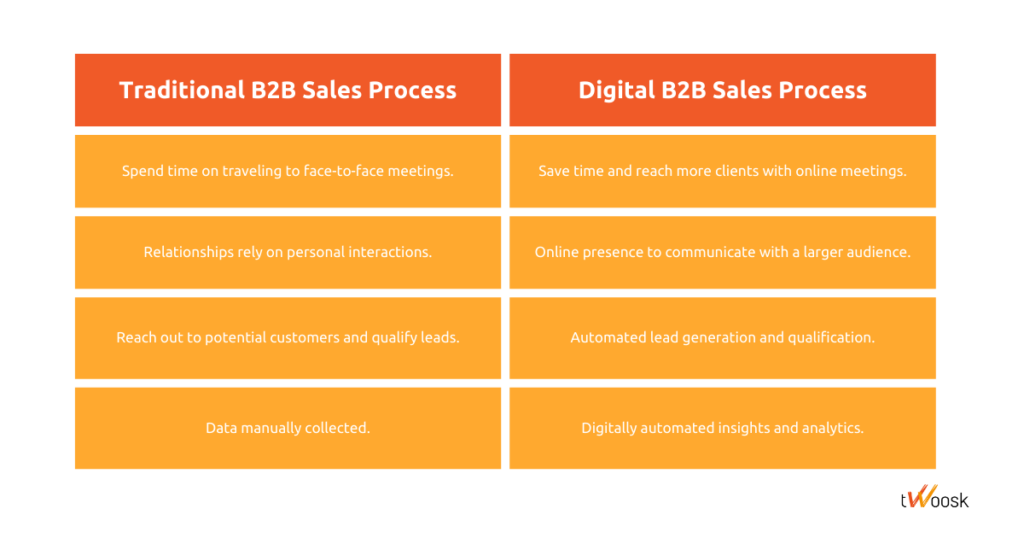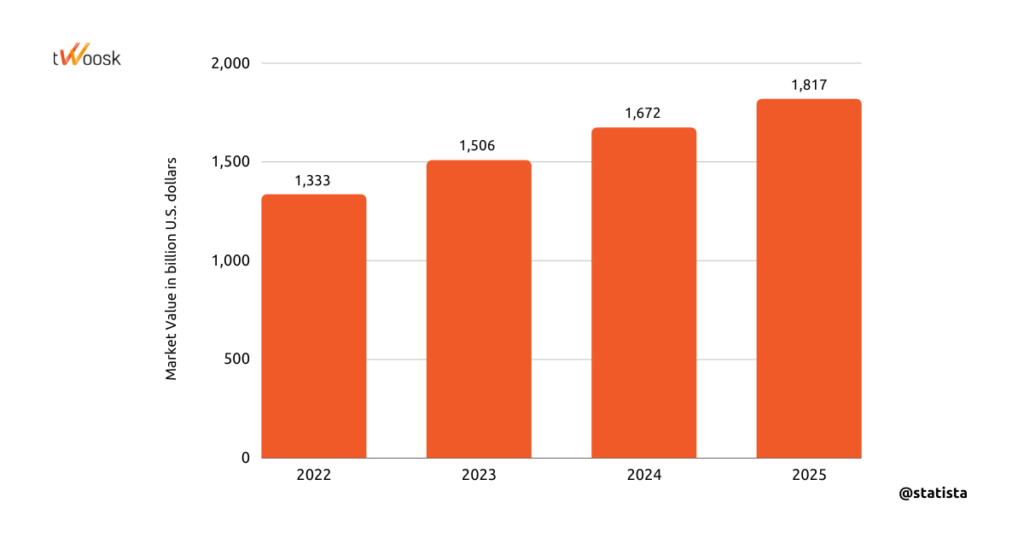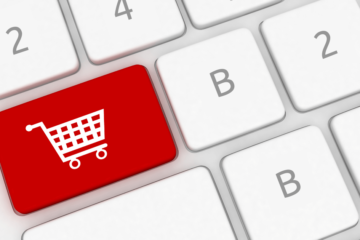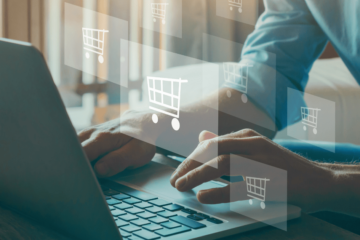
With the digitalization of processes and the evolution of the online environment, new opportunities arise in the sales field. B2C and B2B sales processes suffered changes, to respond to people new buying behaviors. For that reason, having knowledge of digital tools and developing new skills, become crucial for the success of sales professionals approaches.
Although these changes may cause some discomfort, especially to B2B sales reps who are more attached to traditional sales methods, there are some tips that can help ease this process.
B2C Sales vs B2B Sales
B2B sales (business-to-business) refer to the process of selling products or services to other businesses, while B2C sales (business-to-consumer) refer to the process of selling products or services directly to consumers. The main difference between the two is the target audience. B2B sales typically involve longer sales cycles, larger transaction values, and more decision-makers involved in the purchasing process, whereas B2C sales tend to be shorter, with smaller transaction values and fewer decision-makers. B2B sales also often require a higher level of customization and technical expertise.
What is a B2B Sales Funnel?
A B2B sales funnel is a visual representation of the stages a prospective customer goes through in the process of making a purchase from a business-to-business (B2B) company. The funnel typically includes several stages, such as awareness, interest, evaluation, and purchase:
- Awareness: The customer becomes aware of the company and its products or services.
- Interest: The customer expresses interest in learning more about the company and its offerings.
- Evaluation: The customer evaluates the company’s products or services and compares them to those offered by competitors.
- Purchase: The customer decides to buy the product or service.
- Post-purchase: The customer may become a loyal customer and repeat business.
The B2B sales funnel is typically longer and more complex than the B2C sales funnel, as B2B purchases often involve multiple decision-makers and require a higher level of customization. The sales team will use different tactics and strategies for each stage of the funnel to move the prospect through the funnel.
The Modern B2B Sales Process
B2B sales have developed through time, along with digital transformation.
Traditional B2B sales often involve face-to-face meetings and personal interactions. In this process, sales reps typically spend a lot of time on the road visiting customers and are responsible for reaching out to potential customers and qualifying leads. It relies on building relationships and trust through personal interactions. Besides that, in B2B traditional sales, gathering data can be harder as it’s manual.
With the adaptation to the digital world, B2B sales can rely on technology, such as email, social media, and video conferencing, to connect with potential customers. In this sales process, reps can reach a much larger number of prospects remotely. It relies more on creating a strong online presence and providing valuable content to establish trust and credibility. Talking about leads, in the digital process, lead generation and lead qualification is often automated using marketing automation tools. Digital B2B sales provides more insights and analytics to optimize the sales process, as data is more easily gathered.
Overall, the B2B sales process has been heavily influenced by digitalization, and companies are increasingly adopting digital tools and strategies to improve efficiency and reach more customers.

The Birth of Online B2B Buyers
The birth of online B2B buyers can be traced back to the early days of the internet when companies began using the web as a tool for research and communication. As internet usage and e-commerce capabilities grew, B2B companies began to realize the potential of the web for reaching and interacting with customers.
One of the key factors that contributed to the rise of online B2B buying was the increased availability of business-specific products and services on the internet. As more B2B suppliers began to establish a presence online, it became easier for buyers to find and purchase the products they needed from the comfort of their own office.
The growth of e-commerce platforms, such as Amazon Business and Alibaba, also played a significant role in the rise of online B2B buyers. These platforms made it easy for businesses to search for and purchase products from a wide range of suppliers, and to track their orders and deliveries online.
In addition, the advent of digital marketing and automation tools has enabled B2B companies to reach and engage with potential customers more effectively online, which has helped to drive the growth of online B2B buying.
Nowadays, the majority of B2B buyers research products and services online before making a purchase decision, and many of them prefer to complete the purchase process online as well (The online B2B buying process has become more convenient, efficient, and cost-effective for both buyers and sellers.
In Europe, this market is continuously growing, and it’s expected to continue to do so in the following.
Tips to prepare B2B Sales Reps to Online Environment
To better prepare B2B sales reps to the online environment, there are some tips a company can follow:
1.Select the right B2B eCommerce platform: For this, you need to make many evaluations, focused on understanding your business requirements. You should consider scalability, look for a platform that offers B2B features and other integration options, and take into consideration also the level of customization you want, what security measures the platform takes, and so on. It’s also of upmost importance that a company can provide customer service and support.
The most common choices of platform for B2B sales are to either create an ecommerce shop or to join a marketplace. You can read more about the differences of these platforms in the following article, and evaluate which option would be better for your business: Marketplace VS Ecommerce Shops – Differences and Benefits for Business Sellers
2.Align sales and marketing teams: It’s important that these teams work towards the same goal, so both are more efficient and get better results. For this, you should clearly define and communicate shared goals. You can also establish a system of communication and collaboration such as regular meetings and check-ins; use common metrics and KPIs to measure success of the shared goals; use automation technology and CRM tools that can help integrate sales and marketing processes, providing both team with valuable insights; share customer feedback to both teams to help improve strategy; and so on.
3.Adopt social selling techniques: Social selling is the process of using social media platforms to engage with potential customers and build relationships to generate sales. To better benefit from these, you should develop a social media strategy and put efforts into building your personal brand and presence online. Focusing on providing value is important, so you’re able to keep customers engaged on your social platforms. For this, it’s fundamental that you listen to your potential clients and use analytics to track the performance of your social selling efforts, adjusting as needed.
By adopting these social selling techniques, you can use social media to build relationships with potential customers, establish yourself as an expert in your field, and ultimately generate more sales.
4.Get training: Online platforms can be complex, so training your team to use them is very important. Sales reps should be trained on the digital tools and technologies that they will be using to interact with customers and manage their sales activities. This includes things like the chosen ecommerce platform, email, social media, video conferencing, and CRM software. By being trained on these platforms, sales reps will be able to perform more efficiently and get better results.
Nowadays, more complex online platforms provide courses and elaborate help centers that can facilitate the training of these teams.
5.Keep organized and focused: To get better results, organization and maintaining a good focus are key ingredients. For these purposes, sales reps should keep files organized and create schedules with prioritized tasks, meaning tasks have the most importance and urgency. It could also help to use task management tools and develop time-management techniques. To better do better in such areas, B2B sales reps should regularly review their progress to check if they’re on track.
Remember, it takes time to develop good habits, so be patient with yourself and don’t be afraid to make adjustments as needed.
6.Participate in online events: Doing this can help increase and solidify a business’ presence online. These events include webinars, which works as an online seminar; virtual conferences, that are similar to in-person events but held online, often including keynote speakers, breakout sessions and networking opportunities; and you can also live stream physical events, making them available to view online in real-time or later on.
In order to participate in online events, you will typically need access to a computer or mobile device with internet access and the necessary software or apps. Some events may require you to register in advance and provide personal information. It’s a good idea to check the event website for specific instructions and requirements.
Don’t forget to check the time zone, make sure you know when the event starts and ends, and adjust your schedule accordingly.
By following these tips and preparing sales reps efficiently, performance in online b2b sales will surely improve.












